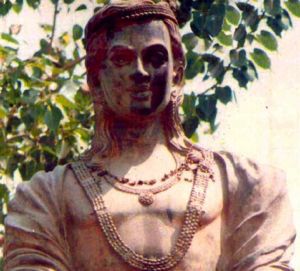
- Harshavardhana was born in 590 AD to King Prabhakaravardhana of Sthaneshvara (Thanesar, Haryana).
- He belonged to the Pushyabhuti also called the Vardhana dynasty.
- He was a Hindu who later embraced Mahayana Buddhism.
- He was married to Durgavati.
- He had a daughter and two sons. His daughter married a king of Vallabhi whereas his sons were killed by his own minister.
- King Harshavardhana deeds were praised by Chinese Buddhist traveller Xuanzang in his writings.
- Autograph of Harsha:

Harsha Ascension
- After Prabhakara Vardhana died, his elder son Rajyavardhana ascended to the throne of Thanesar.
- Harsha had a sister, Rajyashri who was married to king Grahavarman of Kannauj. Sasanka, the Gauda king killed Grahavarman and kept Rajyashri prisoner. This prompted Rajyavardhana to fight against Sasanka. But Sasanka killed Rajyavardhana.
- This led the 16-year old Harshavardhana to ascend the throne of Thanesar in 606 AD.
- He vowed to avenge his brother’s murder and also rescue his sister.
- For this, he forged an alliance with Bhaskaravarman, the Kamarupa king. Harsha and Bhaskaravarman marched against Sasanka. Ultimately, Sasanka left for Bengal and Harsha became the king of Kannauj also.
King Harshvardhana’s Empire
- On acquiring Kannauj, Harsha united the two kingdoms of Thanesar and Kannauj.
- He moved his capital to Kannauj.
- After the fall of the Guptas, North India was divided into many small kingdoms.
- Harsha was able to unite many of them under his command. He had under his control of Punjab and central India. After Sasanka’s death, he annexed Bengal, Bihar and Odisha.
- He also defeated the Vallabhi king in Gujarat. (The Vallabhi king and Harsha came to a truce by a marriage between Harsha’s daughter and the Vallabhi king Dhruvabhata.)
- However, Harsha’s plans to conquer lands to the south were hampered when the Chalukya king, Pulakesin II defeated Harsha in 618-619 A.D. This sealed Harsha’s southern territorial limit as the Narmada River.
- There were two types of territories under Harsha. One was directly under him and the other type was those that were feudatories.
- Direct territories: Central Provinces, Bengal, Kalinga, Rajputana, Gujarat
- Feudatories: Jalandhar, Kashmir, Kamarupa, Sind, Nepal
- Even the feudatories were under the tight command of Harsha. Harsha’s reign marked the beginning of feudalism in India.
- Huen Tsang visited India during Harsha’s reign. He has given a very favourable account of king Harsha and his empire. He praises his generosity and justice.
- Harsha was a great patron of the arts. He himself was an accomplished writer. He is credited with the Sanskrit works Ratnavali, Priyadarshika and Nagananda.
- Banabhatta was his court poet and he composed the Harshacharita which gives an account of Harsha’s life and deeds.
- Harsha generously supported the Nalanda University.
- He had a good tax structure. 1/4th of all the taxes collected were used for charity and for cultural purposes.
- Harsha was a competent military conqueror and an able administrator.
- Harsha was the last king to rule over a vast empire in India before the invasions by the Muslims.
Harsha’s death
- Harsha died in 647 AD after ruling for 41 years.
- Since he died without any heirs, his empire disintegrated very soon after his death.
